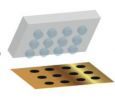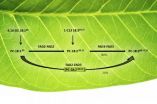Conducting polymer films decorated with biomolecules for cell research use
2014-05-09
(Press-News.org) The ability to create conducting polymer films in a variety of shapes, thicknesses and surface properties rapidly and inexpensively will make growing and testing cells easier and more flexible, according to a team of Penn State bioengineers.
"The ultimate goal of this collaborative project is to be able to create a substrate for growth and manipulation of cells," said Sheereen Majd, assistant professor of bioengineering. "Cells on a surface need to recognize biomolecules like extracellular matrix proteins to be able to adhere and grow. We ultimately would like to be able to use these polymer films to manipulate adhesion, growth, proliferation and migration of cells."
Majd and her team are creating patterned films of conducting polymers on gold substrates by electrodeposition through hydrogel stamps. They report their results today (May 9) in Advanced Materials.
The researchers create their hydrogel stamps from agarose -- a sugar extracted from seaweed -- poured into molds. While most of the current experiments use arrays of dots, because the researchers use molded stamps, a wide variety of shapes -- dots, squares, lines -- are possible.
The stamp is dipped in a solution of monomer and a dopant and placed on the gold surface. An electrical current through the hydrogel and gold polymerizes the monomer and dopant at the surface. If a biomolecule of interest is also included in the stamping solution, it becomes embedded in the polymer film as well.
Because the presence of dopant is important for the electrical conductivity of these polymers, only areas where monomer and dopant exist together form conductive films of polymer. The process takes from one to two minutes and the longer the current is applied, the thicker the film.
The researchers were able to produce a series of films using the same monomer but different dopants and biomolecules by altering the solution on various parts of the stamp. In this way researchers can change the surface properties and functionality of the films. The stamp can also be used multiple times before re-inking becomes necessary, simplifying and speeding up the process.
Creating arrays of different biomolecules and different shapes in conducting polymers is especially important when studying excitable cells like neurons or muscle cells because they react to electricity.
Conducting polymer arrays will allow manipulation of cells using chemical and electrical signals, expanding the ways cells can be treated. Varying films laid down on one substrate can put multiple experiments all in one place.
INFORMATION:
Also working on this project were SooHyun Park and Guang Yang, graduate students in bioengineering; Nrutya Madduri, visiting scholar; and Mohammad Reza Abidian, assistant professor of bioengineering.
The Charles E. Kaufman Foundation at the Pittsburgh Foundation provided partial support for this work.
ELSE PRESS RELEASES FROM THIS DATE:
Grape consumption may offer benefits for symptomatic knee osteoarthritis
2014-05-09
Fresno, CA – New research presented last week at the Experimental Biology conference in San Diego, California, suggests that regular grape consumption may help alleviate pain associated with symptomatic osteoarthritis of the knee, and improve joint flexibility and overall mobility. Researchers attribute these potential benefits to the polyphenols found in grapes.
The sixteen week clinical study, undertaken by Texas Woman's University, was designed to investigate the benefits of grape consumption on inflammation and osteoarthritis outcomes. 72 men and women with knee ...
Calcium supplements not associated with increased risk of cardiovascular disease in women
2014-05-09
Boston, MA – Calcium supplements are widely taken by women for bone health. Previous studies have suggested that calcium supplements may increase risk of cardiovascular disease, but the data has been inconsistent. A new study by researchers at Brigham and Women's Hospital (BWH) did not find that calcium supplement intake increases risk of cardiovascular disease in women.
The study is published online this month in Osteoporosis International.
Researchers examined supplemental calcium use and incident cardiovascular disease in a prospective cohort study of 74,245 women ...
Study validates air sampling techniques to fight bioterrorism
2014-05-09
ST. LOUIS – Air and surface sampling techniques currently used by the US government are effective in fighting bioterrorism and potentially saving lives, a Saint Louis University researcher finds.
Results published in Biosecurity and Bioterrorism by Alexander Garza, M.D., MPH, former chief medical officer at the Department of Homeland Security and a team of researchers from Los Alamos National Lab reviewed the data from a series of experiments simulating a bioterrorism attack against the Pentagon. Garza is now the associate dean for public health practice and associate ...
New species of metal-eating plant discovered in the Philippines
2014-05-09
Scientists from the University of the Philippines, Los Baños have discovered a new plant species with an unusual lifestyle — it eats nickel for a living — accumulating up to 18,000 ppm of the metal in its leaves without itself being poisoned, says Professor Edwino Fernando, lead author of the report. Such an amount is a hundred to a thousand times higher than in most other plants. The study was published in the open access journal PhytoKeys.
The new species is called Rinorea niccolifera, reflecting its ability to absorb nickel in very high amounts. Nickel hyperaccumulation ...
Plants' oil-desaturating enzymes pair up to channel metabolites
2014-05-09
UPTON, NY-Plant scientists at the U.S. Department of Energy's Brookhaven National Laboratory have found that certain enzymes responsible for desaturating fatty acids, the building blocks of oils, can link up to efficiently pass intermediate products from one enzyme to another. "Engineering these enzyme interactions to channel metabolites along desired metabolic pathways could be a new approach for tailoring plants to produce useful products," said Brookhaven biochemist John Shanklin, lead author on a paper reporting the results in the Journal of Biological Chemistry.
Getting ...
Leadless pacemaker showing promising results after 1 year
2014-05-09
Vivek Reddy, MD, Director of Arrhythmia Services for The Mount Sinai Hospital, reported his promising12-month follow-up data showing the world's first leadless pacemaker is demonstrating overall device performance comparable to conventional pacemakers. Dr. Reddy presented the one-year LEADLESS study data findings during his late-breaking clinical trial presentation on May 9 at Heart Rhythm 2014, the Heart Rhythm Society's 35th Annual Scientific Sessions in San Francisco, CA.
The LEADLESS study's long-term follow-up has evaluated 32 patients with a slowed heartbeat, bradycardia, ...
Scientists decode epigenetic mechanisms distinguishing stem cell function and blood cancer
2014-05-09
Researchers at Dartmouth's Norris Cotton Cancer Center have published results from a study in Cell Reports that discovers a new mechanism that distinguishes normal blood stem cells from blood cancers.
"These findings constitute a significant advance toward the goal of killing leukemia cells without harming the body's normal blood stem cells which are often damaged by chemotherapy," said Patricia Ernst, PhD, co-director of the Cancer Mechanisms Program of the Norris Cotton Cancer Center and an associate professor in Genetics at the Geisel School of Medicine.
The study ...
Study identifies mechanism by which intestinal enzyme maintains microbial balance
2014-05-09
Massachusetts General Hospital (MGH) investigators have identified the mechanism by which an enzyme produced in the intestinal lining helps to maintain a healthy population of gastrointestinal microbes. In their report in American Journal of Physiology – Gastrointestinal and Liver Physiology, the research team describes finding that intestinal alkaline phosphatase (IAP) promotes the growth of beneficial bacteria by blocking the growth-inhibiting action of adenosine triphosphate (ATP) – an action first described in this paper – within the intestine.
"We found that ATP ...
NASA sees system 90E just after earthquake hit Mexico's Guerrero State
2014-05-09
VIDEO:
This movie of imagery from NOAA's GOES-West satellite from May 7 at 14:15 UTC to May 9 at 14:15 UTC shows System 90E's progression and movement on land in southwestern...
Click here for more information.
As the dissipating tropical low pressure system known as System 90E continued rain on Guerrero State in southern Mexico, the U.S. Geological Survey reported a 6.4 magnitude earthquake occurred there on Thursday, May 8 around noon local time (1 p.m. EDT). NASA's Aqua satellite ...
Bioprinting a 3D liver-like device to detoxify the blood
2014-05-09
Nanoengineers at the University of California, San Diego have developed a 3D-printed device inspired by the liver to remove dangerous toxins from the blood. The device, which is designed to be used outside the body -- much like dialysis – uses nanoparticles to trap pore-forming toxins that can damage cellular membranes and are a key factor in illnesses that result from animal bites and stings, and bacterial infections. Their findings were published May 8 in the journal Nature Communications.
Nanoparticles have already been shown to be effective at neutralizing pore-forming ...






